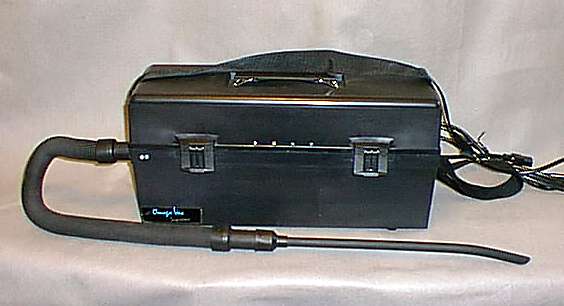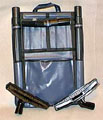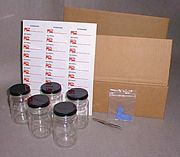In addition to providing non-fluctuating temperature and relative humidity, an HVAC (heating, ventilating and air-conditioning unit) should clean and filter the air. Filtration systems promote adequate ventilation and reduce pollutants by removing dust, particles and harmful gases.
Gases and particles are the two components of air pollution. Particles from burning fuels or cigarette smoke are sooty and tarry, acidic from adsorbed sulfuric acid, and contain trace metals, such as iron, which start degradation. Dust is abrasive, unsightly, and may absorb acidic fumes or moisture from the air. Absorbed water damages glass and metals. Abrasive particles act as little saw teeth, cutting organic material when it expands and contracts from humidity fluctuations or scratching finely polished surfaces.
Acid corrodes metals and destroys organic material. Sulfur dioxide, a common pollutant gas, is formed from burning fossil fuels. It turns into sulfuric acid in the presence of water and can rapidly disintegrate carbonate materials such as chalk, limestone, marble, and alkaline sandstone. It also embrittles and yellows plant fibers such as paper, cotton, linen, rayon, and wood; causes "red rot" in leather; attacks paints and pigments; breaks down synthetic materials such as nylon and rubber; and corrodes metal.
Oxidizers, primarily ozone and nitrogen dioxide, are produced when oxygen breaks down. Ultraviolet rays in the upper atmosphere, sunlight on car exhaust fumes (photochemical smog), or certain lamps and electrical equipment such as electrostatic precipitators and photocopy machines (neither should be located near collection storage), create ozone or nitrogen dioxide. Oxidizers react with all organic materials causing structural breakdown. They attack dyes, pigments, inks, cotton, basketry, paper and polyesters. Nitrogen dioxide also forms nitric acid in the presence of high relative humidity, resulting in damage that is similar to that caused by sulfuric acid.
|
NA255: Dangerous Materials: Chemical Poisons in Native American and Ethnographic Artifacts Course Description & Info Instructor: Nancy Odegaard Student Login Price: $150.00 Oct 4 – Oct 29, 2010 Sign up at www.nathpo.org Students must be staff at a tribal institution and meet NATHPO qualifications. This course is subsidized by the Institute of Museum and Library Services through a grant awarded to NATHPO. |
Books and products we recommend:
 Express Vac, our smallest vacuum, weighs 8 lb. (with accessories and box) and has a top handle. Measures 12”x 8.25”x 9.5”. Fabric carrying Tote sold separately. Three filtration systems are available: (1) a bag and shell filter combination, (2) a disposable, anti-dump canister filter in a recycled plastic housing or (3) a HEPA filter cartridge. Low suction makes this vacuum ideal for collection cleaning. See micro-tools under accessories.
Express Vac, our smallest vacuum, weighs 8 lb. (with accessories and box) and has a top handle. Measures 12”x 8.25”x 9.5”. Fabric carrying Tote sold separately. Three filtration systems are available: (1) a bag and shell filter combination, (2) a disposable, anti-dump canister filter in a recycled plastic housing or (3) a HEPA filter cartridge. Low suction makes this vacuum ideal for collection cleaning. See micro-tools under accessories.
| Express Vac with dust bag filter | $149 | |
| Express Vac with toner cartridge filter | $159 | |
| Express Vac with HEPA cartridge filter | $199 | |
| Express Vac Carry Tote | $30.50 | |
| Express Vac dust bag filters (10 bags, 1 shell) | $25.10 | |
| Express Vac toner cartridge filters (2/pack) | $25.00 | |
| Express Vac HEPA cartridge filters (2/pack) | $44.25 |
 Omega Vac Supreme, weighing 12 lb., has a shoulder strap and lid storage area for accessories. Measures 19.5” x 9” x 6.25”. Choice of filter determines level of dust retention. Omega Series standard filters are designed to capture dust, dirt, soot, pollen, black toner and most color toner. The optional HEPA filters are designed to capture fumes, atmospheric dust, all color toner and other ultra-fine particulate. Both filters are disposable, anti-dump canisters. The vacuum meets UL and CSA certified safety standards. Great for general exhibit and storage room cleaning. Suction is stronger than normally desired for cleaning collections.
Omega Vac Supreme, weighing 12 lb., has a shoulder strap and lid storage area for accessories. Measures 19.5” x 9” x 6.25”. Choice of filter determines level of dust retention. Omega Series standard filters are designed to capture dust, dirt, soot, pollen, black toner and most color toner. The optional HEPA filters are designed to capture fumes, atmospheric dust, all color toner and other ultra-fine particulate. Both filters are disposable, anti-dump canisters. The vacuum meets UL and CSA certified safety standards. Great for general exhibit and storage room cleaning. Suction is stronger than normally desired for cleaning collections.
| Omega Vac Supreme | $292.50 | |
| Omega Vac Supreme with HEPA filter | $304.50 | |
| Omega Vac Supreme filter (single) | $14.00 | |
| Omega Vac Supreme filters (double pack) | $27.50 | |
| Omega Vac HEPA Filter (single) | $33.50 | |
| Omega Vac ULPA .12 micron filter (this is a special order item) | $62.50 | |
| Omega Vac Supreme Deluxe Backpack | $106.00 |
 HCTV Vacuum, our largest vacuum, is designed for high volume users. A foot pedal makes it easy to clean material while sitting at a table or lab bench. Its rolling base doubles as a tray for storing the vacuum’s accessories. With a five-gallon capacity, this vacuum offers two levels of filtration: Toner and dust filter bucket and HEPA filter bucket, 5 gallon. Great for general exhibit and storage room cleaning. Suction is stronger than normally desired for cleaning collections. It comes with an extra-long flexible stretch hose, increasing your reach.
HCTV Vacuum, our largest vacuum, is designed for high volume users. A foot pedal makes it easy to clean material while sitting at a table or lab bench. Its rolling base doubles as a tray for storing the vacuum’s accessories. With a five-gallon capacity, this vacuum offers two levels of filtration: Toner and dust filter bucket and HEPA filter bucket, 5 gallon. Great for general exhibit and storage room cleaning. Suction is stronger than normally desired for cleaning collections. It comes with an extra-long flexible stretch hose, increasing your reach.
| HCTV Vacuum w/5 gallon ESD safe Toner filter | $575.00 | |
| HCTV Vacuum w/5 gallon HEPA filter | $587.50 | |
| HCTV 5 Gallon bucket filter | $66.50 | |
| HCTV 5 Gallon HEPA bucket filter | $73.25 | |
| HCTV Deluxe Backpack | $106.00 |
 Vacuum Accessories fit our Atrix vacuums, making them more flexible.Micro-tools attach to the hose to create a finer cleaning capability. Longer hoses and hose couplers ensure any distance can be reached with your Atrix vacuum without risking the collection. We carry a Tote for the Express Vac and filters for all of our vacuums.
Vacuum Accessories fit our Atrix vacuums, making them more flexible.Micro-tools attach to the hose to create a finer cleaning capability. Longer hoses and hose couplers ensure any distance can be reached with your Atrix vacuum without risking the collection. We carry a Tote for the Express Vac and filters for all of our vacuums.
| Micro-tools | $16.75 | |
| 6 ft. hose | $41.00 | |
| 10 ft. hose | $49.00 | |
| Hose coupler (joining two hoses) | $21.50 | |
| Flexneck crevice tool | $15.95 |
 Materials Testing Kit Acid fumes are a danger to any collection. This kit provides information and supplies to aid in the testing of construction materials. The Materials Testing Kit includes 24 glass jars, acid detection strips, tweezers, silver coupons, lead coupons, aluminum foil, 1 sheet of preprinted labels and an instruction manual.
Materials Testing Kit Acid fumes are a danger to any collection. This kit provides information and supplies to aid in the testing of construction materials. The Materials Testing Kit includes 24 glass jars, acid detection strips, tweezers, silver coupons, lead coupons, aluminum foil, 1 sheet of preprinted labels and an instruction manual.
| Materials Testing Kit | $120.00 | |
|
Polished lead coupons (24) | $22.15 | |
|
Polished silver coupons (24) | $24.95 | |
| Materials Testing Kit Booklet | $15.00 |
| $5.00 |

Vol.1 No.4
Indoor Generated Pollutants
| $5.00 |
Links to related information on other sites:
Indoor Air Pollution in Museums and Archives
http://www.iaq.dk/
Indoor Air Pollution: Detection and Mitigation of Carbonyls, Presentation Abstracts and Additional Notes
http://www.iaq.dk/iap/iap1998/1998_contents.htm
Pollution in the photographic archive
– a practical approach to the problem
http://www.iaq.dk/papers/iada1999.htm
Indoor Air Pollution: Detection and Prevention
http://www.iaq.dk/iap/iap1999/1999_contents.htm
CARBONYL POLLUTANTS : A MUSEUM PERSPECTIVE
http://iaq.dk/iap/iap1998/1998_13.htm
Ozone: an Invisible Menace
http://palimpsest.stanford.edu/waac/wn/ wn05/wn05-1/wn05-102.html
1.8 Protection of Works of Art from Damage Due to Photochemical Smog.
http://www.getty.edu/conservation/science/abstracts/1.8.html
1.9 Protection of Works of Art from Damage Due to Deposition of Airborne Particulate Matter
http://www.getty.edu/conservation/science/abstracts/1.9.html
1.10 Protection of Works of Art from Damage Due to Atmospheric Nitric Acid
http://www.getty.edu/conservation/science/abstracts/1.10.html
1.11 Museum Survey of Indoor PAN, Nitrogen Dioxide, Nitric Acid, Chlorinated Hydrocarbons, Sulfur Dioxide, and Total Reduced Sulfur
http://www.getty.edu/conservation/science/abstracts/1.11.html
1.13 Study of the Effects of Sulfur Dioxide and Nitrogen Dioxide on Deacidified Papers-Part 1
http://www.getty.edu/conservation/science/abstracts/1.13.html
1.14 Study of the Effects of Sulfur Dioxide and Nitrogen Dioxide on Deacidified Papers-Part 2
http://www.getty.edu/conservation/science/abstracts/1.14.html
1.19 Museum Survey for Indoor Aldehydes, Ketones, and Organic Acids
http://www.getty.edu/conservation/science/abstracts/1.19.html
1.20 Exposure of Artists’ Colorants to Airborne Formaldehyde, Peroxyacetyl Nitrate (PAN) and (PAN Nitrogen Dioxide Ozone).
http://www.getty.edu/conservation/science/abstracts/1.20.html
Pollutants in Museums
http://www.getty.edu/conservation/science/pollutants/index.html
First results of a pilot decontamination in a PCP polluted building by means of a humidity controlled thermal process
http://palimpsest.stanford.edu/byauth/ gagelmann/gagelmann.html

